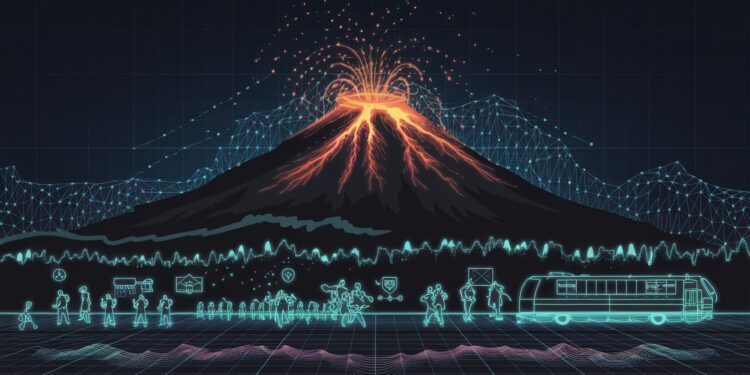In a spectacle that has drawn equal parts wonder and concern, thousands of tourists have flocked to Sicily’s Mount Etna to witness the volcano’s latest breathtaking eruptions. However, the massive influx of visitors has created a dangerous situation, blocking narrow streets and preventing rescue services from reaching those in need of assistance.
“Wild” and “Extremely Dangerous” Scenes
Salvo Cocina, Sicily’s head of regional civil protection, described the recent tourism at Etna as “wild” and “extremely dangerous.” In a Facebook post, Cocina warned that day-trippers drawn by the exceptional views had parked their cars along narrow streets, creating traffic standstills and impeding the passage of rescue vehicles.
As darkness falls, the situation becomes extremely dangerous, with rising risks of falls and people sinking into the snow.
– Salvo Cocina, Sicily’s head of regional civil protection
Despite these warnings, tourists continued to flock to the area, with some getting dangerously close to the lava flows in their quest for the perfect photo or video. Viral clips on social media showed visitors mere centimeters from the molten lava, ignoring the 500-meter safety perimeter established by local authorities.
Rescue Operations Hindered
The overwhelming tourist presence has not only put individual lives at risk but has also significantly hampered rescue efforts. On Monday, eight people, including two minors, got lost during an excursion and were only located several hours later. The previous day, a 48-year-old man suffered a fractured foot from a fall, while four others went missing overnight.
Firefighters have been called in to assist locals and manage the flow of tourists through the overcrowded streets. However, the sheer volume of visitors has made it challenging for emergency services to respond promptly to incidents, raising concerns about the safety of both tourists and residents.
The Perils of “Volcano Tourism”
The recent events at Mount Etna highlight the growing phenomenon of “volcano tourism” and the risks associated with it. While witnessing an active volcano can be an awe-inspiring experience, it is crucial for visitors to prioritize safety and follow the guidelines set by local authorities.
Though visually striking, [getting close to the lava] exposes them to serious risks, as the lava, interacting with the snow, can instantly vaporize it and, with the thermal energy released, may violently hurl fragments or rocks.
– Carlo Caputo, mayor of nearby town Belpasso
The situation at Etna is not an isolated incident. Italy, home to the most UNESCO World Heritage Sites globally, has been grappling with the challenges of overtourism in recent years. From the canals of Venice to the Amalfi Coast, popular destinations have been overwhelmed by visitors, straining local infrastructure and negatively impacting residents’ quality of life.
Balancing Tourism and Sustainability
As the global tourism industry recovers from the impact of the COVID-19 pandemic, it is crucial to prioritize sustainable tourism practices. This includes not only managing visitor numbers but also educating tourists about responsible behavior and respect for local communities and natural environments.
Local authorities, tourism boards, and travel companies must work together to develop strategies that promote responsible tourism while ensuring the safety of visitors and residents alike. This may involve implementing crowd control measures, enhancing emergency response capabilities, and investing in infrastructure to support sustainable tourism growth.
A Call for Responsible Travel
The events at Mount Etna serve as a stark reminder of the importance of responsible travel. As tourists, it is our duty to respect the places we visit, follow local guidelines, and prioritize safety above all else. By doing so, we can ensure that the world’s natural wonders, like the awe-inspiring eruptions of Etna, can be enjoyed sustainably for generations to come.
It is time for a collective effort to address the challenges of overtourism and foster a more sustainable, responsible approach to travel. Only by working together can we strike a balance between the economic benefits of tourism and the preservation of our planet’s most treasured destinations.
As we witness the spectacular displays of nature’s power at Mount Etna, let us also reflect on our role as global citizens and commit to being responsible stewards of the Earth. The future of tourism, and indeed our planet, depends on it.








